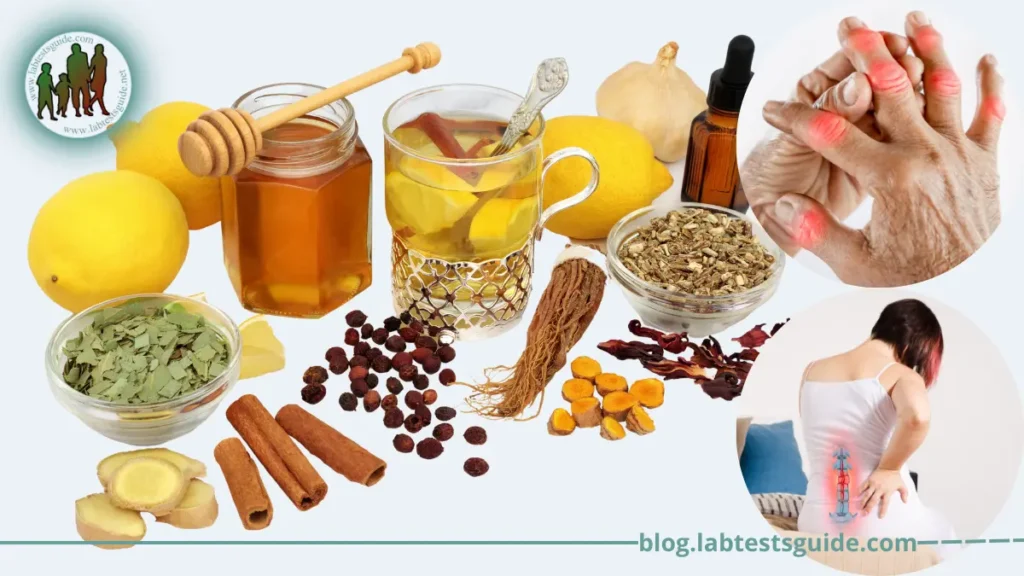Arthritis is a common condition characterized by inflammation and pain in the joints. It can affect people of all ages and is typically chronic, meaning it lasts for a prolonged period. While medical treatments are available to manage arthritis symptoms, many individuals seek natural remedies to alleviate pain and improve their quality of life. These natural remedies can be used in conjunction with conventional treatments or as standalone approaches. In this article, we will explore several natural remedies for arthritis pain that have shown promise in reducing discomfort and promoting joint health.

It’s important to note that while these remedies may provide relief for some individuals, the effectiveness may vary from person to person. It is always advisable to consult with a healthcare professional before initiating any new treatment, especially if you have underlying medical conditions or are taking medications. By incorporating these natural remedies into your arthritis management plan, you can explore additional options for finding relief and improving your overall well-being.
Hot and cold therapy:
Here’s how hot and cold therapy can be utilized.
Heat therapy:
Applying heat to arthritic joints can help relax muscles, improve blood circulation, and relieve pain. You can use various methods to apply heat, such as.
- Heating pads: Place a heating pad on the affected joint for 15-20 minutes at a time. Ensure the temperature is comfortable and avoid falling asleep with the pad on to prevent burns.
- Warm towels: Soak a towel in warm water, wring out the excess, and place it on the affected joint.
- Warm baths or showers: Submerge your body in warm water, allowing the heat to penetrate the joints. Adding Epsom salt to the bath can provide additional relaxation.
Cold therapy:
Cold therapy is effective in reducing inflammation and numbing the pain associated with arthritis. Here’s how to apply cold therapy.
- Ice packs or cold compresses: Wrap ice packs or a bag of frozen vegetables in a towel and apply it to the affected joint for about 15 minutes. Ensure the cold is not directly in contact with your skin to prevent frostbite.
- Cold showers or baths: Taking a cool shower or bath can provide overall relief and reduce joint inflammation.
It’s important to note that some individuals may respond better to heat therapy, while others find cold therapy more effective. You can experiment with both methods to determine which one works best for you. Additionally, it’s advisable to use caution when applying extreme temperatures to your body, especially if you have conditions such as poor circulation or diabetes. If you have any concerns or questions, consult with your healthcare provider for personalized advice on incorporating hot and cold therapy into your arthritis management plan.
Exercise:
Here’s how exercise can help.
- Strengthening muscles: Regular exercise helps strengthen the muscles around the joints, providing better support and stability. Stronger muscles can help alleviate stress and pressure on the affected joints, reducing pain and improving overall function.
- Increasing flexibility and range of motion: Arthritis can lead to stiffness and limited range of motion in the joints. Engaging in exercises that promote flexibility, such as stretching or yoga, can help improve joint mobility and reduce stiffness.
- Promoting weight management: Maintaining a healthy weight is essential for managing arthritis pain, particularly in weight-bearing joints such as the knees and hips. Exercise contributes to weight management by burning calories and increasing metabolism, thereby reducing the strain on joints and decreasing pain.
- Enhancing joint lubrication: Movement and exercise stimulate the production of synovial fluid, which helps lubricate the joints. Improved joint lubrication can reduce friction, ease movement, and alleviate discomfort.
- Boosting mood and overall well-being: Regular physical activity releases endorphins, the body’s natural feel-good hormones. Exercise can help improve mood, reduce stress, and enhance overall well-being, which can indirectly alleviate arthritis pain.
When incorporating exercise into your arthritis management plan, keep the following considerations in mind.
Choose low-impact exercises:
Opt for activities that are gentle on the joints, such as walking, swimming, cycling, and water aerobics. These exercises provide cardiovascular benefits without placing excessive stress on the joints.
- Start slowly and gradually increase intensity: Begin with shorter durations and lower intensity levels, then gradually increase as your body adjusts. Listen to your body and avoid pushing through excessive pain.
- Seek professional guidance: Consult with a healthcare professional or a physical therapist who can recommend specific exercises tailored to your condition. They can provide guidance on proper form, technique, and modifications based on your individual needs.
Remember, it’s important to find a balance between rest and exercise. If you experience severe pain or swelling during or after exercise, modify your routine or consult with your healthcare provider to adjust your exercise program accordingly.
Weight management:
Here’s how weight management can help.
- Reduced joint stress: Losing weight can significantly decrease the load placed on the joints, relieving pressure and reducing pain. Even a modest weight loss can have a noticeable impact on joint health and function.
- Decreased inflammation: Adipose tissue (fat) produces inflammatory substances that can contribute to joint inflammation. By maintaining a healthy weight, you can help reduce systemic inflammation, which may alleviate arthritis symptoms.
- Improved mobility: Excess weight can limit mobility and make it more challenging to engage in physical activities. By managing your weight, you can enhance your overall mobility, making it easier to exercise and perform daily activities with less pain and discomfort.
To effectively manage weight in the context of arthritis, consider the following strategies:
- Balanced, nutritious diet: Focus on consuming a balanced diet that includes plenty of fruits, vegetables, whole grains, lean proteins, and healthy fats. Avoid or minimize processed foods, sugary beverages, and foods high in saturated fats. Consult with a registered dietitian for personalized dietary recommendations.
- Portion control: Pay attention to portion sizes to avoid overeating. Practice mindful eating, savoring each bite and listening to your body’s hunger and fullness cues.
- Regular physical activity: Engage in regular exercise to support weight management efforts. Low-impact exercises like walking, swimming, and cycling are gentle on the joints while still providing cardiovascular benefits.
- Seek support: Consider joining a weight management program or seeking support from a healthcare professional, dietitian, or support group. They can provide guidance, accountability, and tailored strategies to help you achieve your weight management goals.
It’s important to approach weight management as a long-term, sustainable lifestyle change rather than a short-term diet. Gradual and consistent weight loss is generally recommended, aiming for a loss of 1-2 pounds per week. Remember to consult with your healthcare provider before starting any weight management program, as they can provide personalized guidance based on your specific health needs and considerations.
Dietary changes:
Here are some dietary changes that may be beneficial.
- Omega-3 fatty acids: Omega-3 fatty acids have anti-inflammatory properties and can help reduce joint inflammation and pain. Include fatty fish such as salmon, mackerel, and sardines in your diet. If you’re not a fan of fish, you can also opt for plant-based sources like flaxseeds, chia seeds, and walnuts. Omega-3 supplements, such as fish oil capsules, can also be considered, but consult with your healthcare provider for guidance.
- Antioxidant-rich fruits and vegetables: Colorful fruits and vegetables are packed with antioxidants, which help fight inflammation and oxidative stress. Include a variety of berries, leafy greens, citrus fruits, tomatoes, broccoli, and bell peppers in your diet. These foods provide essential vitamins, minerals, and phytonutrients that support joint health.
- Whole grains: Opt for whole grains like brown rice, quinoa, whole wheat bread, and oats. They provide fiber, which has been associated with reduced inflammation and improved gut health. Whole grains also contribute to weight management, which can alleviate joint stress.
- Healthy fats: Incorporate healthy fats in your diet, such as olive oil, avocados, and nuts. These fats have anti-inflammatory properties and can help reduce joint inflammation.
- Limit processed foods and refined sugars: Processed foods and those high in refined sugars can contribute to inflammation and weight gain. Minimize your intake of sugary drinks, desserts, processed snacks, and fast food. Instead, focus on whole, unprocessed foods.
- Spices and herbs: Certain spices and herbs possess anti-inflammatory properties. Turmeric, ginger, garlic, cinnamon, and rosemary have been shown to have potential benefits in reducing arthritis pain and inflammation. Incorporate them into your cooking or consider supplements like turmeric capsules (consult with your healthcare provider before starting any supplements).
- Stay hydrated: Drink an adequate amount of water throughout the day to keep your body hydrated and support joint function.
Every individual may respond differently to dietary changes, so it’s essential to listen to your body and pay attention to any specific food sensitivities or allergies. It may be helpful to keep a food diary to track how certain foods affect your symptoms. If needed, consult with a registered dietitian who specializes in arthritis or inflammatory conditions for personalized dietary recommendations that align with your specific needs and preferences.
Herbal supplements:
Here are some herbal supplements commonly used for arthritis pain.
- Turmeric: Turmeric contains a compound called curcumin, which has anti-inflammatory properties. It may help reduce joint inflammation and alleviate arthritis pain. Curcumin supplements or turmeric capsules are available, but their effectiveness can vary. Consult with your healthcare provider for guidance on dosage and potential interactions.
- Ginger: Ginger is another herb known for its anti-inflammatory properties. It may help reduce joint pain and swelling. Ginger can be consumed in various forms, including fresh ginger, ginger tea, or ginger supplements. Talk to your healthcare provider before using ginger supplements, especially if you are on blood-thinning medications.
- Boswellia: Boswellia, also known as Indian frankincense, has been used in traditional medicine to relieve joint pain and inflammation. It may inhibit certain enzymes that contribute to inflammation. Boswellia supplements are available, but their efficacy varies. Consult with your healthcare provider for recommendations.
- Green tea extract: Green tea contains compounds called polyphenols, which have antioxidant and anti-inflammatory properties. Some studies suggest that green tea extract may help reduce arthritis pain and inflammation. Green tea can be consumed as a beverage, or green tea extract supplements can be considered under the guidance of a healthcare professional.
It’s important to remember that herbal supplements are not a substitute for conventional medical treatment, and they may not work for everyone. Always consult with your healthcare provider before starting any new supplements, especially if you have underlying medical conditions or are taking medications. They can provide personalized advice based on your specific situation and help you make informed decisions regarding the use of herbal supplements for arthritis pain.
Acupuncture:
Here’s what you should know about acupuncture for arthritis pain.
- Pain relief: Acupuncture is thought to stimulate the release of endorphins, which are natural pain-relieving chemicals in the body. This can help reduce arthritis pain and improve symptoms.
- Inflammation reduction: Some research suggests that acupuncture may have anti-inflammatory effects, which can benefit individuals with arthritis. By reducing inflammation, acupuncture may help alleviate pain and improve joint function.
- Individual response: The response to acupuncture can vary from person to person. While some individuals may experience significant pain relief, others may not experience the same level of benefits. It is important to have realistic expectations and consider acupuncture as part of a comprehensive arthritis management plan.
- Safety and side effects: Acupuncture is generally considered safe when performed by a trained and licensed acupuncturist. The risk of side effects is minimal, but some individuals may experience mild bruising, soreness, or temporary worsening of symptoms. It’s crucial to ensure that the acupuncturist uses sterile needles and follows proper hygiene practices.
- Consultation with a professional: If you are interested in trying acupuncture for arthritis pain, seek a qualified acupuncturist who has experience in treating musculoskeletal conditions. They will assess your condition, discuss your symptoms and goals, and create a personalized treatment plan.
It’s important to note that acupuncture should not be used as a standalone treatment for arthritis pain. It is best utilized as part of a comprehensive approach that includes medical management, exercise, and other lifestyle modifications. Consult with your healthcare provider before starting acupuncture or any new treatment, especially if you have underlying medical conditions or are taking medications. They can provide guidance and ensure that acupuncture is safe and appropriate for your specific situation.
Topical treatments:
Here are some commonly used topical treatments for arthritis pain.
- Topical NSAIDs: Nonsteroidal anti-inflammatory drugs (NSAIDs) can be found in topical forms and are applied directly to the skin. They work by reducing inflammation and relieving pain. Topical NSAIDs may be an option for individuals who want to avoid oral medications or for those who have localized joint pain. Examples include diclofenac gel or cream, ketoprofen gel, and ibuprofen gel.
- Capsaicin: Capsaicin is a substance derived from chili peppers that can be found in topical creams or patches. It works by depleting a chemical called substance P, which is involved in transmitting pain signals. Capsaicin creams can provide temporary relief by numbing the area and reducing arthritis pain.
- Counterirritants: Counterirritant topical treatments contain ingredients such as menthol, camphor, or wintergreen oil. They create a cooling or heating sensation on the skin, which can help distract from and relieve arthritis pain. These products do not address the underlying cause of arthritis but may offer temporary relief.
- Topical lidocaine: Lidocaine is a local anesthetic that can be found in topical forms. It numbs the skin and can provide temporary relief from arthritis pain. Topical lidocaine products are available as creams, gels, or patches.
- Herbal or natural remedies: Some topical treatments contain herbal ingredients, such as arnica, eucalyptus oil, or lavender oil. While the evidence supporting their effectiveness is limited, some individuals find these natural remedies helpful in managing arthritis pain.
When using topical treatments, it’s important to follow the instructions provided and consult with a healthcare professional if you have any concerns or questions. It’s also essential to consider any potential interactions with other medications you may be taking and to be aware of possible skin sensitivities or allergies to the ingredients in the topical treatments.
Conclusion:
Arthritis pain can be challenging to manage, but there are various natural remedies that can help alleviate symptoms and improve joint function. In this discussion, we explored some effective natural remedies for arthritis pain, including hot and cold therapy, exercise, weight management, dietary changes, herbal supplements (with caution), acupuncture, and topical treatments.
Hot and cold therapy can provide relief by reducing inflammation and soothing sore joints. Exercise, specifically low-impact activities, strengthens muscles, improves flexibility, and promotes weight management. Maintaining a healthy weight is crucial for reducing joint stress and inflammation. Dietary changes focused on consuming anti-inflammatory foods, such as omega-3 fatty acids, fruits, vegetables, whole grains, and healthy fats, can support joint health.
While herbal supplements may have potential benefits, it’s important to consult with a healthcare professional before using them, as they may interact with other medications or have side effects. Acupuncture, when performed by a trained professional, may help reduce arthritis pain and inflammation.
Lastly, topical treatments like NSAIDs, capsaicin, counterirritants, lidocaine, and herbal remedies can offer localized relief for arthritis pain, although individual responses may vary.
Remember, it’s essential to work closely with your healthcare provider to develop a comprehensive arthritis management plan that incorporates the natural remedies discussed, along with any prescribed medications or treatments. They can provide personalized guidance and ensure that the chosen remedies are safe and suitable for your specific needs.






